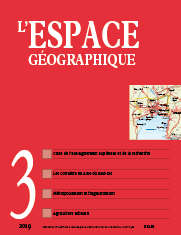

The Kunming-Vientiane-Bangkok high-speed railway line: From Greater Mekong’s sub-region corridors to new silk roads (4 fig.)
In 2010, China decided to build the first high-speed Kunming- Vientiane-Bangkok railway line to add to the highway corridors of the first two decades in the Greater Mekong region. Given that this line is a key instrument of its ambitions in South-East Asia, China had to modify the finances in accordance with the changes in the policies of the partner countries and the risk of incurring excessive debts. In doing so, it has shown unexpected flexibility, which allowed it to start the construction in 2016. The pragmatism that it has shown in the mainland South- East Asia will be useful for carrying out its even more ambitious project of New Silk Roads across Euro-Asia.
keywords: CHINA-SOUTHEAST ASIA RELATIONS, ECONOMIC CORRIDOR, GLOBALISATION, HIGH-SPEED RAILWAYS, REGIONALISATION SILK ROADS
Metropolization in Southern Vietnam (8 fig.; 1 photo)
Since the Đôi Moi (renovation) reforms initiated in 1986, Hô Chi Minh City (HCMC) Region has played a key role in the economic development of Vietnam. The relations between the member provinces, historically marked by the dominance of HCMC, deeply evoled, through the creation of new inter-provincial urbanindustrial corridors. How do such spatioeconomic dynamics reveal the territorial selectivity of the metropolization, as well as the fragmentary characteristic of regional development in Southern Vietnam? Our work tends to examine the mechanisms by which local development dynamic, fundamentally marked by competitive logic, has contributed to strengthening links between provinces within this urban region.
keywords: INDUSTRIALIZATION, INTER-PROVINCIAL CORRIDOR, PROJECT, REGIONAL DEVELOPMENT, URBANISM, HO CHI MINH CITY
Guillaume LE ROUX. The “fragmentation” of the popular peripheries of Latin American cities challenged by mobilities: The case of Bogotá (1993-2009) (5 fig.; 2 photos; 1 tabl.)
In Bogotá, as in many other Latin American cities, informal urbanization has been the main driver of peripheral urban sprawl during the course of the last century. Today, the landscape of the peripheries has changed with the more or less advanced consolidation of informal neighbourhoods and the formal production of large residential complexes or gated communities. Many authors tend to describe these phenomena in terms of urban fragmentation. Based on the case study of the working-class peripheries of Bogotá, this article offers a more nuanced insight into the ongoing fragmentation process by analysing the spatial mobility of the inhabitants.
keywords: BOGOTÁ, GATED COMMUNITY, INFORMAL NEIGHBOURHOOD, WORKING-CLASS PERIPHERY, SPATIAL MOBILITY, URBAN FRAGMENTATION
Disappearance and permanence of urban agriculture in Antananarivo (4 fig.; 12 photos)
This paper analyses the spatial extent of agriculture in Antananarivo. Depending on the landscape units (agri-urban units), the cultivated area is decreasing, the same or increasing. In the city centre, cultivated land is decreasing but at a slower pace that what is usually estimated. In the agricultural lowlands at the urban front, the evolution of the extent of agricultural land is related to the infrastructure. Finally in the less densely populated urban areas, buildings and cultivated lands are expanding at the expense of pasture. The urban system is producing an intensification of agricultural practices. Urban agriculture mapping is feeding urban policy debates.
keywords: ANTANANARIVO, LAND TENURE, MADAGASCAR, SPATIAL ANALYSIS, URBAN AGRICULTURE, URBAN PLANNING
Book reviews
In this issue of l’Espace géographique, you will find critical reviews of the following books
KEIL R. (2017). Surburban Planet. Laking the World Urban from the Outside in. Cambridge, Medford: Polity Press, coll. «Urban Future Series», 258 p. (Guy Baudelle, université de Rennes 2) ISBN: 978-0-7456-8312-6
FAU N., FRANCK M. (dir.)(2019). L’Asie du Sud-Est. Émergence d’une région, mutation des territoires. Paris: Armand Colin, coll. «Horizon», 438 p. (Michel Bruneau, CNRS Bordeaux) ISBN: 978-2-200-62698-3, eBook ISBN: 978-2-200-62748-5
L’espace géographique 2/19![]()
![]() L’espace géographique 4/19
L’espace géographique 4/19
For subscribe or buy this issue: BELIN
![]() L’Espace géographique: contents
L’Espace géographique: contents
Last modified: April 21, 2020